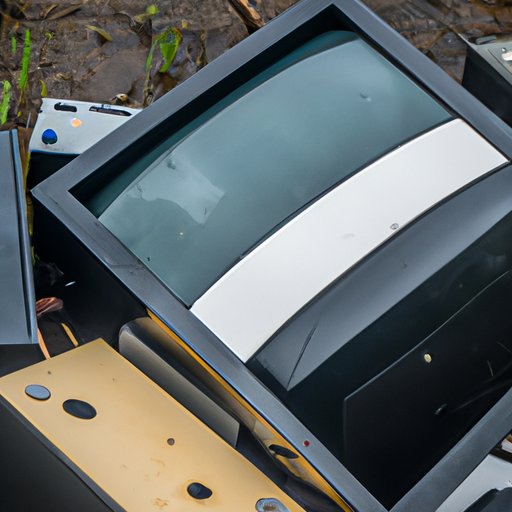
I. Introduction
When it comes to disposing of a broken TV, many people are at a loss. TVs are large, bulky, and contain hazardous materials that require special handling. Improper disposal can pose a danger to the environment and public health. In this article, we will explore the various ways to dispose of a broken TV safely and responsibly.
II. Five Environmentally-Friendly Ways to Dispose of Your Broken TV
Environmentally-friendly disposal is a great way to get rid of your broken TV while minimizing the impact on the environment. There are several options available for recycling or donating a broken TV.
One option is to recycle the TV. Many e-waste recyclers offer services that will take the TV off your hands and safely dispose of it. Recycling a TV has several benefits, including reducing the amount of waste in landfills and conserving valuable resources.
You can also donate your broken TV to a charity or non-profit organization. Some charities will accept broken electronics and refurbish them for use in their programs. Donating a TV is a great way to give back to the community while also reducing waste.
When choosing an e-waste recycler or donation program, make sure to look for certifications that indicate adherence to environmental and ethical standards. The Environmental Protection Agency (EPA) provides a list of certified e-waste recyclers on their website.
III. Donating vs Disposing: What to Do with Your Broken TV
Deciding between donating or disposing of your broken TV can be a tough decision. There are pros and cons to both options.
Donating a TV has the potential to benefit others and lower the amount of waste in landfills. However, some donation centers may have strict quality standards for electronics, and a broken TV may not be accepted. It is important to research the donation options in your area and their policies regarding broken electronics.
Proper disposal, on the other hand, ensures that the TV’s hazardous materials do not pose a risk to public health and the environment. Many e-waste recycling programs offer free or low-cost disposal services. It is important to follow guidelines for safe disposal to protect yourself and others from harm.
IV. How to Repurpose Your Broken TV in Creative Ways
If you’re looking for a creative way to get rid of your broken TV, consider repurposing it instead. Dismantling the TV allows you to salvage valuable parts that can be used in a variety of DIY projects.
Before repurposing a TV, it is important to properly disassemble it to avoid injury and exposure to hazardous materials. Some parts that can be salvaged include speakers, circuit boards, and glass screens. These parts can be used in projects like home theaters, sound systems, and art installations.
V. The Risks of Improper TV Disposal and How to Avoid Them
Improper TV disposal poses a risk to the environment and public health. TVs contain hazardous materials like lead, mercury, and cadmium that can pollute soil and water if not disposed of properly.
Some people may be tempted to dispose of their TV in the trash or by burning it, but these methods are dangerous and illegal. Instead, choose a safe disposal option like recycling or donating the TV.
It is important to stay informed on responsible disposal methods and to avoid harmful practices. The EPA provides resources for responsible e-waste disposal and guidelines for safe handling of hazardous materials.
VI. Where to Take Your Broken TV for Professional Disposal
If you choose to have your TV professionally disposed of, it is important to find a reputable company. Many e-waste recyclers offer services for proper TV disposal.
It is important to research the company’s environmental and ethical certifications and to choose a company that adheres to safe disposal practices. Some cities and towns have local resources for e-waste disposal, such as drop-off centers or pick-up services.
VII. DIY TV Disposal: How to Break Down and Dispose of Your TV on Your Own
If you choose to dispose of your TV on your own, it is important to follow safety guidelines and properly dismantle the TV. Some parts of a TV can be recycled or disposed of with household hazardous waste, while others may need to be taken to a specialized facility.
It is important to wear protective gear like gloves and eyewear when handling electronics and to avoid damaging hazardous materials. The EPA provides guidelines for safe DIY e-waste disposal.
VIII. Conclusion
Proper TV disposal is essential for protecting the environment and public health. Whether you choose to recycle, donate, or repurpose your broken TV, it is important to follow safe disposal practices. Remember to research your options and choose certified companies, and to stay informed on responsible waste practices.
For more information on responsible e-waste disposal and safe handling of hazardous materials, visit the EPA website.





